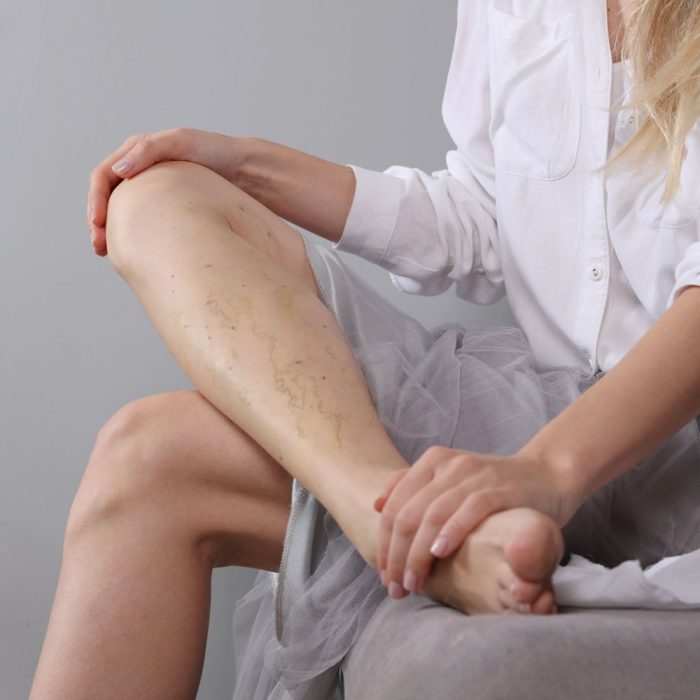Table of Contents
ToggleNutrition and Exercise to Reduce Spider Veins
Spider veins, or telangiectasias, are small, dilated blood vessels that appear close to the surface of the skin, often forming web-like patterns. They are typically red, blue, or purple and are most commonly found on the legs and face. While spider veins are usually harmless, they can be a source of cosmetic concern for many people. Genetics, hormonal changes, and aging are well-known factors that contribute to the development of spider veins. However, lifestyle choices, particularly diet and exercise, can also play a significant role in either exacerbating or mitigating their appearance.
The role of diet in the formation and prevention of spider veins
A balanced diet is very important to maintain the health and elasticity of blood vessels. Foods rich in antioxidants, vitamins, and minerals support overall vascular health and can prevent the weakening of arteries that lead to spider veins.
1. Antioxidants
These are essential to fight inflammation and prevent damage to blood vessels. Fruits such as blueberries, strawberries, and citrus fruits are rich in antioxidants that help protect and strengthen arteries.
2. Vitamin C
This vitamin is necessary for the production of collagen, which is necessary to maintain the structure and flexibility of veins. A diet rich in vitamin C, including foods such as oranges, kiwis, and bell peppers, helps improve vein health.
3. Flavonoids
Found in foods such as dark chocolate, green tea, and red wine, flavonoids improve blood circulation and lower blood pressure, which can minimize the risk of spider veins.
Conversely, a diet rich in processed foods, refined sugars, and unhealthy fats can lead to weight gain, poor circulation, and increased pressure on the arteries. For example, too much sodium can cause the body to retain water, leading to swelling and increased pressure on the vein walls, which exacerbates the formation of spider veins.
How exercise affects spider veins
Regular physical activity is one of the most effective ways to prevent and manage spider veins. Exercise promotes healthy blood flow and lowers venous pressure, which is key to maintaining strong and flexible veins.
1. Cardiovascular exercise
Activities such as walking, running, cycling and swimming improve blood circulation and prevent blood pooling in the legs, which is one of the common causes of spider veins. These exercises also help maintain a healthy weight, which reduces pressure on the leg veins.
2. Strength exercises
Exercises that strengthen the leg muscles are very useful. The leg muscles act as a pump and help push blood back towards the heart. Squats, lunges and leg raises are effective in strengthening muscle strength and improving venous return.
3. Stretching and flexibility
Stretching exercises, such as yoga or pilates, can improve overall flexibility and reduce muscle tension, which in turn supports better circulation and reduces the risk of spider veins.
On the other hand, a sedentary lifestyle can exacerbate the development of spider veins. Sitting or standing for a long time causes blood to accumulate in the legs and increases the pressure on the veins and helps them to expand and look.

Weight management and its importance on spider veins
Maintaining a healthy weight is very important in preventing spider veins. Excess body weight puts pressure on the veins, especially in the lower limbs, which can weaken the veins and make them more visible. Weight management through diet and exercise not only helps reduce this pressure but also improves overall circulation, thereby reducing the likelihood of spider veins.
Hydration and its effects on the health of spider veins
Staying hydrated is another important factor in vein health. Proper hydration helps maintain blood volume and flow and prevents it from becoming thick or sticky. Dehydration can lead to poor circulation, which exacerbates the development of spider veins. Including enough water and hydrating foods, such as cucumbers, melons, and leafy greens, in your diet can make a significant difference.
The impact of lifestyle choices on spider veins
In addition to diet and exercise, other lifestyle factors can affect the appearance of spider veins. Avoiding prolonged exposure to the sun, especially without proper protection, can prevent damage to the skin and blood vessels. Wearing compression stockings can also help improve blood flow to the legs and reduce the appearance of spider veins. In addition, avoiding high-heeled shoes and choosing shoes that support the natural movement of the foot can reduce pressure on the leg veins.
The appearance of spider veins is influenced by a combination of genetic, hormonal, and lifestyle factors. While some of these factors are beyond our control, diet, and exercise are powerful tools in managing and preventing spider veins. A diet rich in Nutr
Conclusion
It is important for people considering skin tag removal in plano , laser hair removal in plano ,microneedling in plano, Hydrafacial in plano, Microdermabrasion plano, Laser electrolysis plano, Nail Fungus plano, Rosacea Treatment in plano, Spider Vein Removal plano, Wrinkle Reduction in plano, Botox in plano, Hifu in plano, to undergo a full consultation with a qualified doctor or cosmetologist – Aesthetician Nasrin – to assess their suitability for this procedure and discuss their .
No comment yet, add your voice below!